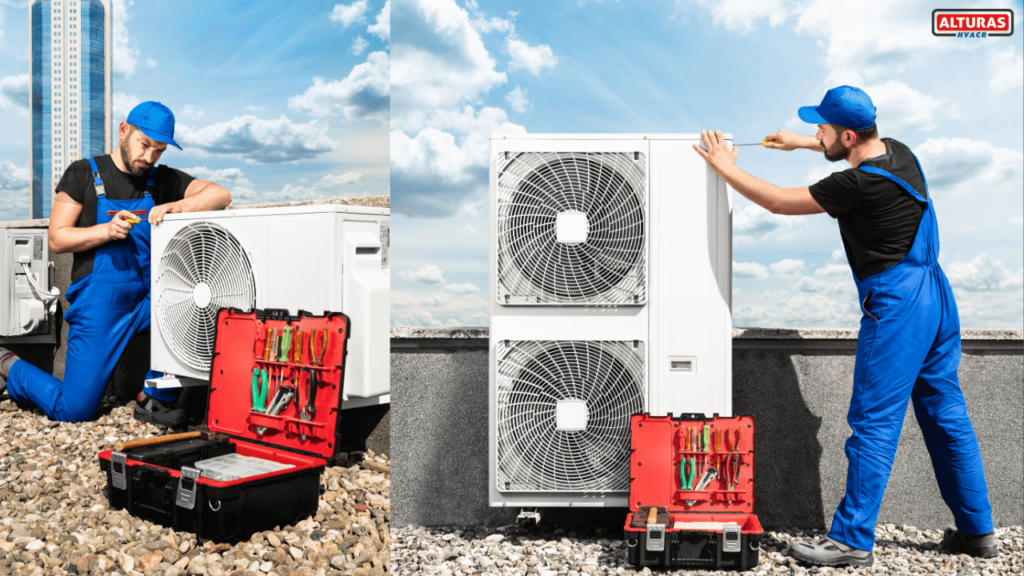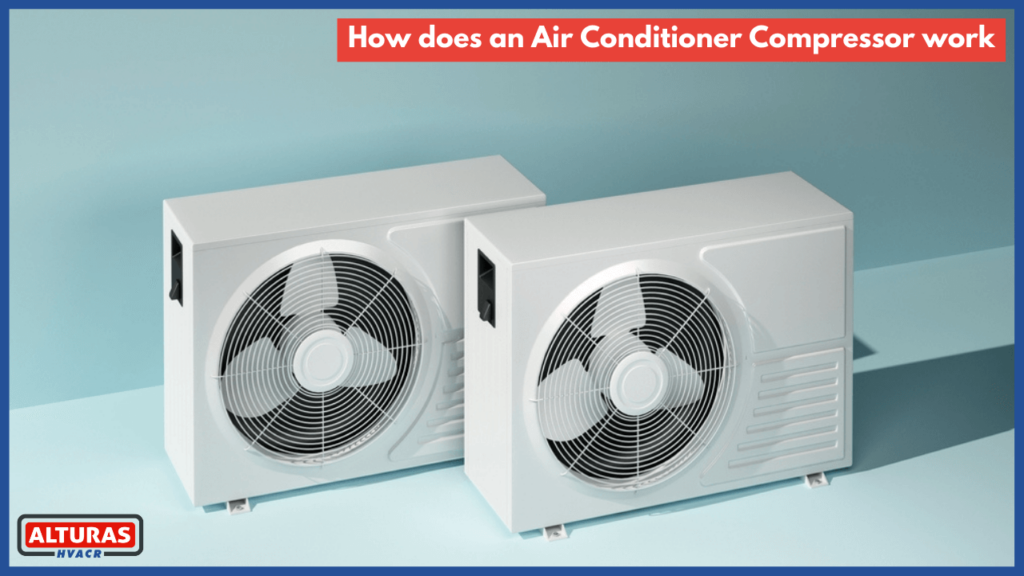Air conditioning is a common piece of equipment in many households and commercial spaces. An air conditioner works by removing heat from your home, sending the heat outdoors, and recirculating newly cooled air throughout your house. However, have you ever wondered how your air conditioner brings in cooled air inside your house?
One of the key components of an air conditioner is the compressor, which plays a crucial role in this secret cooling process. Therefore, in this article, we will explore how does an air conditioner compressor work and the different types of compressors.
Parts of the AC System
Central air conditioning systems are made up of three parts i.e. an evaporator, a condenser, and a compressor. The compressor serves as a bridge between the evaporator, located inside your air conditioner, and the condenser, the unit outside your home.
How Does An AC Work?
The air conditioner pulls warm air through return air vents from rooms throughout your house. Coils in the evaporator unit, which are filled with refrigerant, absorb the heat. The heat-filled refrigerant is pumped outdoors to the condenser unit so that the heat can be released. The refrigerant travels back to the evaporator where the process begins again.
What is An Air Conditioner Compressor?
An air conditioner compressor is a mechanical device that compresses refrigerant gas in the air conditioning system. The compressor increases the pressure of the refrigerant, which increases the temperature of the gas. The high-pressure and high-temperature gas then flows through the air conditioning system to cool and dehumidify the air.
Types of Air Conditioner Compressors
There are two main types of air conditioner compressors: reciprocating and rotary.
Reciprocating compressors
Reciprocating compressors use pistons and cylinders to compress the refrigerant gas. These compressors are typically found in smaller air conditioning units. They are ideal for residential use. They are simple, reliable, and energy-efficient, making them a popular choice for home cooling.
Rotary compressors
Rotary compressors, on the other hand, use a rotating vane or scroll to compress the refrigerant gas. These compressors are found in larger air conditioning units and are ideal for commercial use. They are more complex than reciprocating compressors and require more maintenance. However, they are more efficient and provide better cooling.
How Does an Air Conditioner Compressor Work? Step-by-Step Process

Check out the step-by-step process of how does an AC compressor works:
Location and Function:
The compressor is situated in the outdoor unit of an air conditioner and is powered by an electric motor. It comprises a piston and a cylinder, essential for its operation. The piston moves vertically within the cylinder, compressing the refrigerant gas during its motion. Integral valves regulate the flow of refrigerant in and out of the compressor.
Intake of Low-Pressure Gas:
The process begins with the compressor drawing in low-pressure, gaseous refrigerant from the evaporator coil.
Compression:
The compressor then compresses this low-pressure gas, causing its temperature and pressure to rise significantly.
High-Pressure, High-Temperature Gas:
As a result of compression, the refrigerant transforms into a high-pressure, high-temperature gas.
Condensation in the Condenser Coil:
The high-pressure gas flows to the condenser coil located outside the building, releasing heat into the surrounding air and transforming it into a high-pressure liquid.
Expansion Valve:
The high-pressure liquid then passes through the expansion valve, where its pressure drops, leading to a sudden decrease in temperature.
Evaporation in the Evaporator Coil:
The low-pressure, low-temperature liquid now enters the evaporator coil located inside the building. It absorbs heat from the indoor air, transforming it back into a low-pressure gas.
Return to the Compressor:
The low-pressure gas returns to the compressor to initiate the cycle again. This continuous process maintains a controlled temperature and humidity level within the building.
Regulation by Thermostat:
The thermostat monitors the indoor temperature and signals the compressor to adjust its operation, ensuring the desired comfort level is maintained.
Common AC Compressor Issues

Since the compressor is one of the crucial parts of an air conditioning system, it can sometimes develop problems. Be mindful of these signs to know if your air conditioner compressor needs repair:
- Ticking sound or loud noise
- A drastic change in airflow or indoor temperature
- The air conditioning system is operational but fails to produce cool air
- Leaking moisture or refrigerant around the unit
- AC compressor won’t turn off
- Fan damaged or blocked
If you are experiencing any of these above signs contact our air conditioning repair Los Angeles.
Air Conditioner Compressor Maintenance
Air conditioner compressor maintenance is inevitable for the smooth and uninterrupted functioning of your air conditioner. Only a professional and experienced Los Angeles HVAC company should perform any tune-ups on your air conditioner’s compressor. During an air conditioning maintenance visit, Alturas HVAC air conditioning service technicians will check the refrigerant levels to ensure enough refrigerant is present. Running your air conditioner with too little refrigerant can put stress on the compressor. Over time, this stress could cause the compressor to fail.
Now that you understand how AC compressor works, keep it working properly and efficiently by scheduling an air conditioning maintenance appointment today. Contact Alturas HVAC contractors now.

